The modifications Tesla made to its Autopilot, partially automated driving system, including how it ensures drivers are paying attention and how it identifies and reacts to objects, are being closely scrutinized by U.S. auto safety regulators.
According to a statement on July 6, the National Highway Traffic Safety Administration requested specifics about modifications made to all system versions, including dates and thorough descriptions.
The request is a large component of a more significant effort to determine why Tesla’s using Autopilot has struck emergency vehicles parked along roadways and responding to other situations. All automated driving systems, such as full-self driving, are included, which Tesla owners are testing on public roads.
Since August 2021, the agency has been looking into crashes involving Teslas equipped with autonomous technology. Since 2016, investigators have dispatched teams to look into more than 30 collisions that have resulted in at least 14 fatalities.
In a letter dated July 3 and published on the NHTSA website, the organization requests that Tesla list any modifications made to the systems in the “design, material composition, manufacture, quality control, supply, function, or installation of the subject system, from the start of production to date.”
The letter indicates that Tesla must answer the request by July 19 or risk civil penalties. It also requests an update on a previous response from Sept. 19 of last year.
The modifications made by Tesla as part of the “Full Self-Driving” software recall in February are included in the NHTSA’s request. Due to the software’s potential to violate traffic regulations, NHTSA pressured Tesla to recall approximately 363,000 vehicles. Additionally, the NHTSA stated that the system might take risky behaviors such as proceeding directly through an intersection from a turn-only lane, a yellow traffic light carelessly, or failing to react to speed limit changes.




